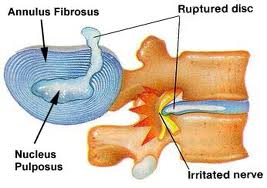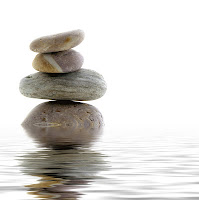The Discovery
Pain comes in all forms and sizes but the most important thing is not to ignore it as i did. I had a dull ache back in September in my lower back, and found it really uncomfortable driving back from a break in Cornwall in October. It felt like needles in my left buttock. I put it down to doing too much and not stretching enough. I took up yoga for the first time in years. Every downward dog was so uncomfortable but i ploughed onwards, thinking it could only be doing me good. I was in a gentle class for those recovering from injury so what harm could i possibly be doing??! I was seeing my regular osteopath rather more regularly than usual and still the pain was there and i was beginning to find it tiresome. I reached the stage after 3 months where the only relief i got was from rolling a tennis ball against the wall down each side of my spine on a daily basis. By Christmas Day i was sitting on a pilates ball in a back brace on pain killers. The point is, i left it too late and by ignoring the warning signs became immobile and off work.
Diagnosis
My two worst positions were bending forwards and sitting, so that ruled out driving, catching a train or bus, eating at a table, putting on socks from standing and massaging. My osteopath had instructed me to see a GP for an MRI as he suspected a prolapsed disc or an annular disc tear. A normal X-ray would not show up this kind of soft tissue damage as is only really useful for bone related issues. Yup - it sounded rather alarming to me too. My first point of call was the GP to get a referral for an MRI scan to find out what i was dealing with. Sounds simple enough? The first two doctors i saw prescribed painkillers. The second referred me to a muscle hub in January as they are trying to reduce unnecessary MRI referrals as they cost the NHS money. I have yet to see anyone (it is now March). I took the bull by the horns as i needed answers before a flight in February, so went down the private route. Vista Diagnostics is a brilliant centre in Waterloo, London. With a referral from a physiotherapist, chiropractor or osteopath, you can contact this company and make a next day appointment and walk out with your MRI on a CD that day. It is not as expensive as you might imagine. £250 bought me peace of mind. Well, kind of as once my osteopath had viewed the images, the prolapsed disc was a reality. Let me explain what a prolapse means. It is often called a herniated or slipped disc although the name is irrelevant, it is what is happening in the spine that matters.
Prolapsed Disc/Slipped Disc/Herniated Disc
Many people have undiagnosed prolapsed discs and will never worry about them as there is no pain involved. A diagnosis only becomes necessary when pain is involved as carrying on with day to day life is hard when you have a niggling sensation 24/7. A prolapse is most common in men and between the ages of 30-50. After 50, the jelly like texture of the nucleus in the disc dries up so there is no longer the risk of nerve pain. A disc as you can see in the image above is the soft cushion between the bony vertebra of your spine. They lie between every single vertebra in your back so in theory any could prolapse but it is usually your lower back or sometimes your neck that suffer. They have a poor blood supply hence the slow recovery rate when one is damaged. There are a plethora of reasons for why it happens but the general gist is, overuse (bending forwards repetitively in a job, sitting hours at a desk, lifting heavy weights etc), posture, inherited weakness or sneezing! What actually happens is the disc tears from the centre outwards and produces a bulge which may or may not prolapse. As the diagram shows the contents of the nucleus in the disc seeps out of the tear and surrounds a nerve which causes shooting pain down the buttock and leg. In more serious cases, bladder and bowel function can be compromised if the nerves at the base of the spine are pressed on. Instant GP appointment required in this case. I fortunately avoided this but as my osteopath told me my prolapse was as severe as they come and he was surprised i was coping without painkillers and functioning. A GP who looked at the scan would have had me straight onto the operating table.
What enables me to cope with back pain?
Hands on Therapy!!! (massage, acupuncture, osteopathy)
The moment i was sat on that pilates ball on Christmas day in a back brace i knew i was going to need help. The pain of getting out of a car and sitting down even on a pilates ball was excruciating. I was not sleeping well as lying on my side was uncomfortable even with pillows between legs. You become tired, and less able to deal with the pain. It is a difficult place to be. That Christmas week alone i saw 4 practitioners for treatment to take some tension out of my muscles which had clamped around the disc to protect it. I am lucky knowing top rate practitioners in the first place but i still had to pay for every treatment. I soon realised that money was going to have to be spent to cure this problem and time. Acupuncture was great at relieving the buttock and back muscles and calming the mind aiding the body to deal with the neural pain. I could take deep tissue techniques from day 1 as the muscles responded well to the pressure and the relief was immense. Listen to your body and what it can take as only you have the answers. Sports massage was effective and i saw an osteopath to occasionally manipulate the discs around the problem disc. It was gentle and effective. I have continued to have treatment once a week (now 2 months into the rehab).
Trace Elements
These I take periodically when the body is "blocked" in some way. In other words, when i am catching lots of colds showing my immune system is not functioning well or when i have had an injury and am experiencing nerve pain. It is a coincidence that i was already taking a product called No7 which treats the nervous system. I added protogel to this which helps heal connective tissue and cartilage, necessary for my disc recovery. A disc consists of several layers of fibrocartilage. I am a firm believer that this alone has aided my ability to tolerate the nerve pain without medication. Trace elements represent 0.01% of our body. They act as catalysts allowing an action in the cell of the body to happen with less time and energy. Trace elements are more important today as there are more reasons for the cells in the body not to function positively because of:
- medication
- pollution
- poor nutrition
- electro magnetic waves
- emotional problems
- rhythm of life - sleep/work/relaxation not in balance
Pilates Exercises and Stretches
For the next month i had a weekly one to one pilates class with the amazing Sue Lloyd who i knew already. I remember trudging through the snow to reach her house on the fair mile as my warm up. It hurt to walk too but i knew i needed to stay mobile. In these classes i learnt how far i could stretch my muscles and the importance of regular stretching and exercise. Impressively without a diagnosis until February, i was able to stretch my hamstrings lying on my back and do pretty much everything except stretching my gluts on my left side (prolapse was to the left) and my left adductors.
Mindful Exercises and Breathing
In order to deal with the lack of sleep which had become chronic, i saw a Sleep Doctor. They exist! A young man called Guy Meadows who works in London is a physiologist who has studied sleep over 4 years and has a PHD in sleep. The basis of his work is a drug free way of dealing with sleep problems and minimising pain. In essence, you imagine your pain in lots of detail...its colour, size, where it is in the body and how it makes you feel and as you acknowledge it, it becomes less difficult to handle. You take the image you have in your mind and place it somewhere else in your body. It is an acceptance of the pain rather than struggling with trying to control it. A simple and effective technique which practised daily does work. Likewise, observing the breath and in so doing, calming the mind helps with pain.
Chair Support
A therapist friend suggested using a wedge to sit on which causes you to sit at such an angle that there is no pressure on the spine. I have taken it everywhere. It comes with me in taxis, at restaurants, in churches - you name it. I have even named it my clutch as it is black and square like and at night time perched under my arm looks like a bag rather than a cushion!!!
Ice and Heat
Instead of painkillers or inflammatories i have spent 20mins every day on an ice pack. It is the time of day when the back is struggling and really does give me enormous relief. I used to have a warm bath too every evening but in time the back becomes stronger and it does not feel essential anymore.
Rest
I do less nowadays. I stopped hiking at weekends and my exercise is pilates style core strength exercises, work, walking 30mins every day and resting in between.
Everyone is unique. I hope to be sitting comfortably by the summer so roughly a year after first feeling pain in the buttock. Listen to your body and respond early when it calls out for some attention. For any information, or to book an appointment with me, call 01491 577480.
Resources:
Osteopath: Bradley Whale 07727692224
Pilates Teacher: Sue Lloyd 07901590948
Seat Wedge: http://www.sittingwell.co.uk/products.asp?categoryID=10836
Back Pain Exercises App: http://shop.feelingprettyremarkable.com/
Sleep Doctor: Dr Guy Meadows http://thesleepschool.org/
Trace Elements: Vanessa Mansergh 01491 577480
Vista Diagnostics: 0845 4503559 (a referral is essential)











